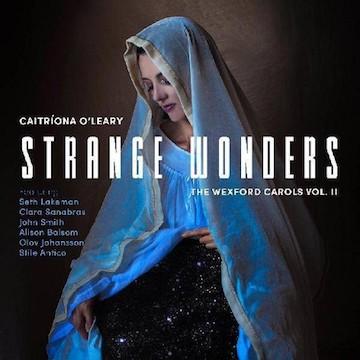December 7, 2021

Caítriona O’Leary, “Strange Wonders: The Wexford Carols, Vol. II” • O’Leary’s first volume of Wexford Carols, first released in 2014 and again two years later, was a joy to a world oversaturated with over-produced, over-played Christmas music. A scholar as well as singer, O’Leary has researched the Wexford caroling tradition, which derives from the poems of Luke Waddinge, a bishop in Co. Wexford during the 17th century, and the 1728 collection of Christmas songs by Fr. William Devereux. Blessed with a voice that is ethereal and crystalline yet not without sinew, she gave new life to these songs, with arrangements that blended Irish traditional music, early music and classical styles, and aided by quite the group of contributors, headlined by Rosanne Cash, Rhiannon Giddens and Tom Jones (as in “Yes, that Tom Jones”), along with Donal Lunny of Planxty and Bothy Band renown. It all made for a refreshingly sublime, graceful, and accessible mesh of folk and sacred music, with the feel of a global village Christmas celebration.
Volume II, “Strange Wonders,” is a smaller-scale but no less pleasing affair. If her collaborators don’t possess quite the star-power of those in Volume I, they are highly accomplished. The other vocalists are Clara Sanabas, also a stellar musician (she plays baroque guitar here) and with a portfolio that includes soundtracks for “The Hunger Games” and “The Hobbit”; Seth Lakeman (violin and viola), a stalwart of the UK folk scene for nearly three decades; Lakeman’s fellow Briton John Smith, one of the more intriguing guitarists in British Isles trad/contemporary folk; and, in a supporting role, the Stile Antico choir. The instrumental ensemble includes trumpet, bass clarinet, renaissance guitar, lute, percussion and even a nyckelharpa (played by Olov Johansson of groundbreaking Scandinavian trio Väsen and a past performer in “A Christmas Celtic Sojourn”).
“Strange Wonders” is more contemplative than its festive predecessor, as O’Leary explains in the sleeve notes: Where Volume I told the familiar narrative of Christmas, the carols for this album are “more meditations on the mystical and spiritually wondrous aspects of the story,” such as Gabriel’s Visitation to Mary and the Meeting of Herod and the Magi. Appropriately enough, the instrumentation and arrangements tend to be on the spare side, which centers attention more fully on the voices.
Sanabras appears on seven of the 11 tracks, harmonizing gorgeously with O’Leary; her baroque guitar makes a fine complement to Simone Collavecchi’s renaissance guitar on three of the tracks, especially “Ye Sons of Men,” which also features Alison Balsom’s stirring trumpet. Smith’s tender, tenor voice trades off with O’Leary and Sanabras on “The Darkest Midnight in December,” with Lakeman’s violin, Johansson’s nyckelharpa and Collavecchi’s lute (along with percussion by Ethan Jones) gently taking up the melody at junctures. Deirdre O’Leary’s nimble, steady bass clarinet anchors “This Feast of St. Sylvester,” while the mesmerizing “A Carol for St. John’s Day” brings in Lakeman’s distinctive voice and viola, and there is an outstanding build to the track, as Stile Antico joins Lakeman and Johannson in creating a backdrop for Collavecchi’s solo on lute.
“The Enniscorthy Christmas Carol,” which closed Volume I, is also reprised here as the final track – but with a vastly different arrangement and feel, as O’Leary and Sanabras combine with Stile Antico and Balsom on the final verse, a positively angelic high harmony rising among the voices to proclaim a traditional, far more profound aspect of the Christmas spirit:
And when thro’ life we wend our way
’Mid trials and sufferings day by day
In faith and hope, whate’er befall
We’ll wait in peace His holy call
[thewexfordcarols.com]

